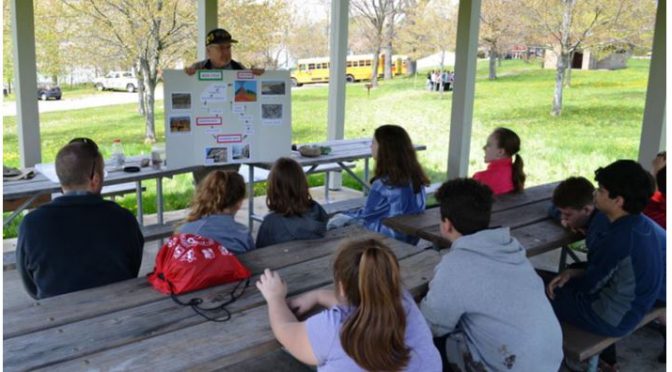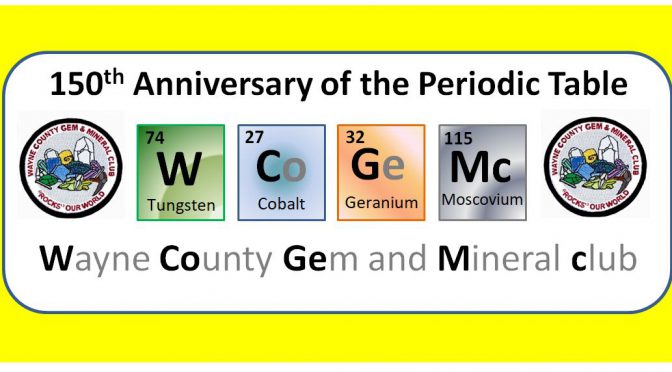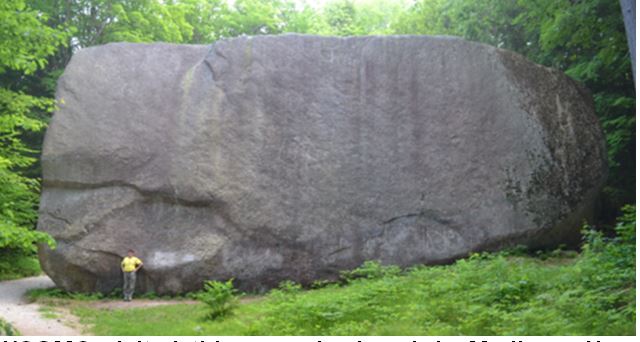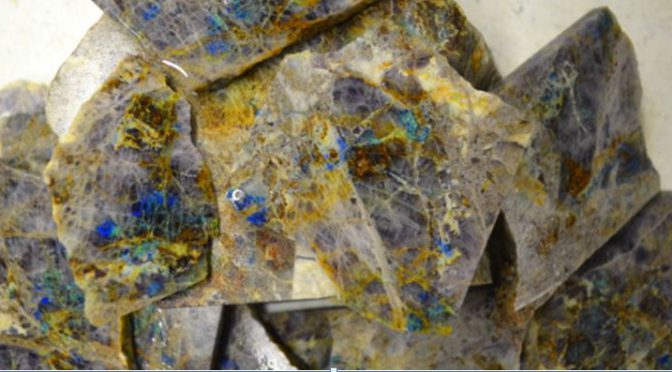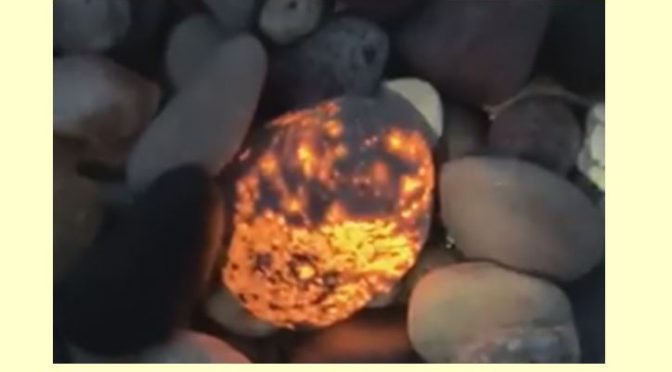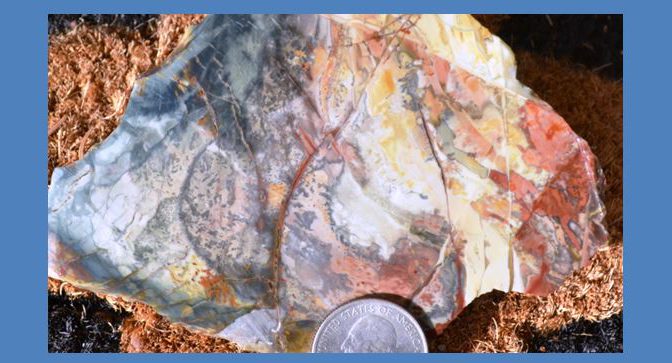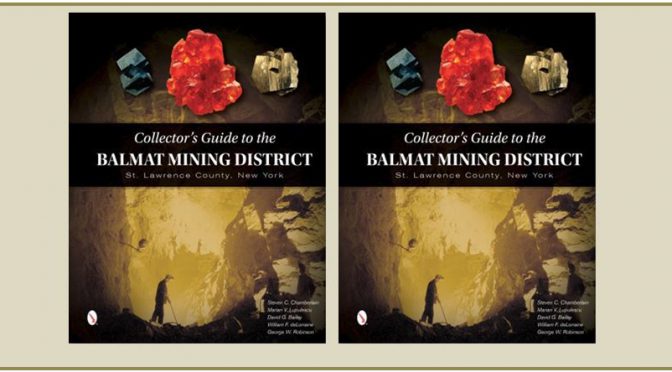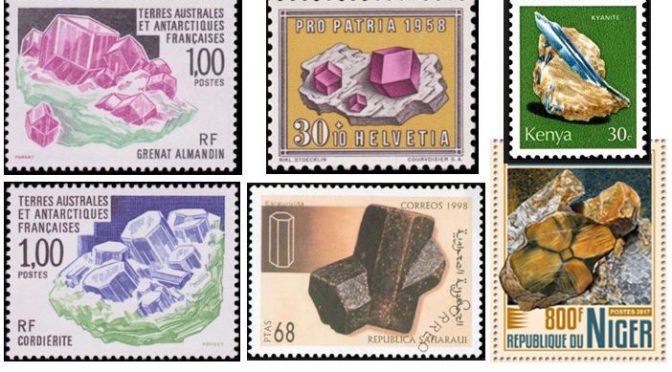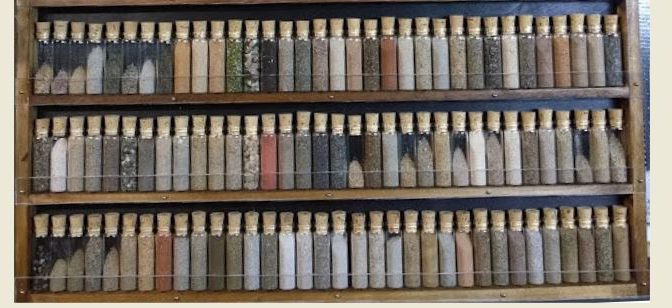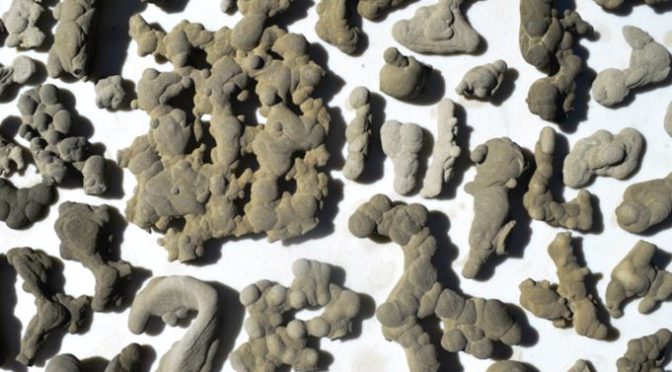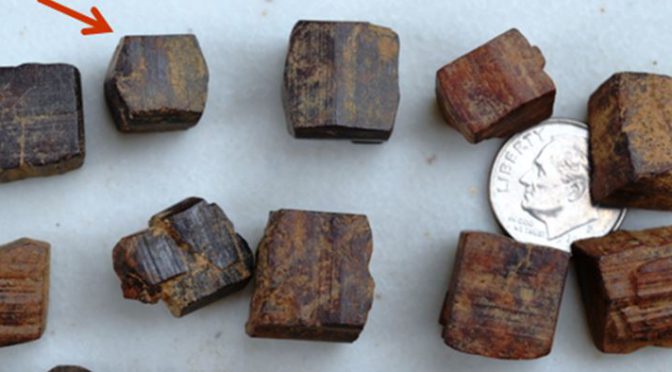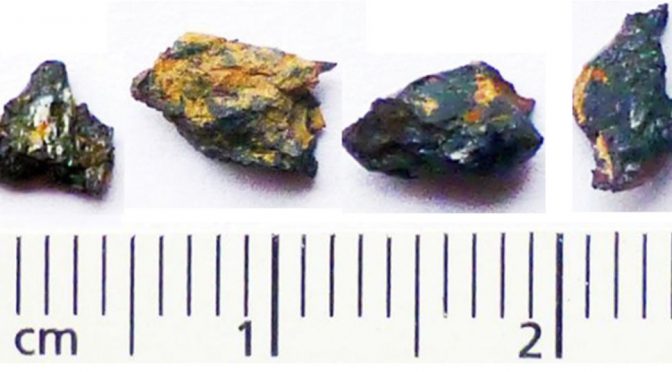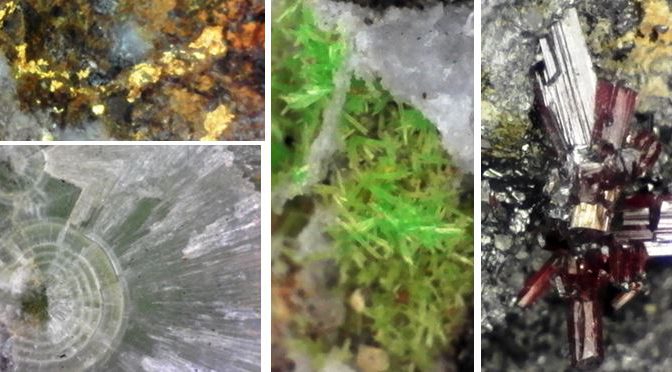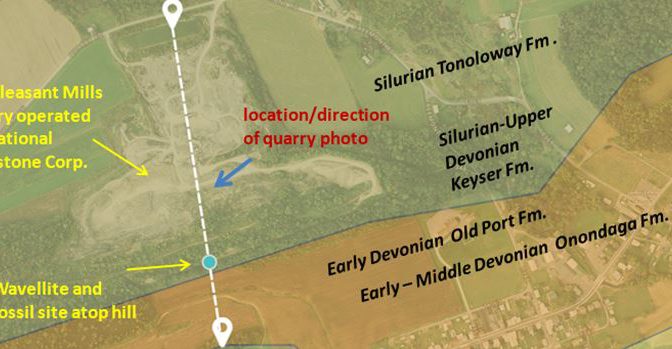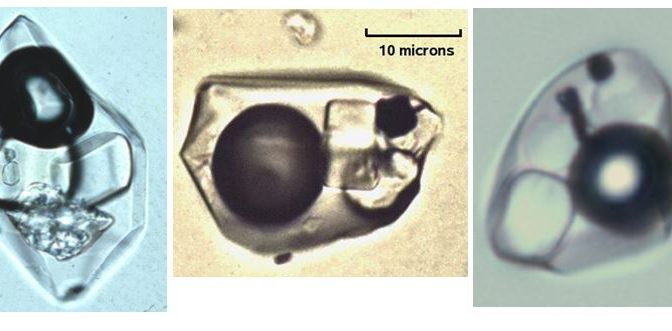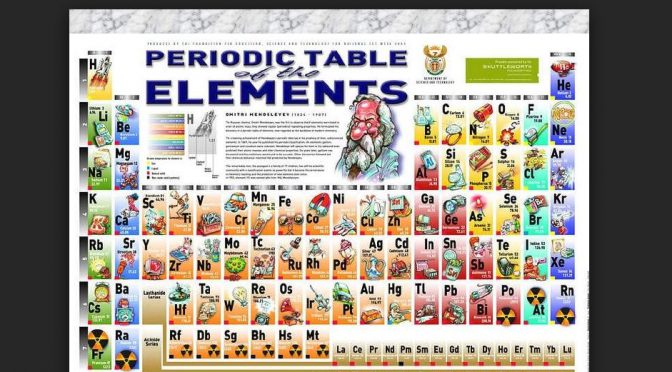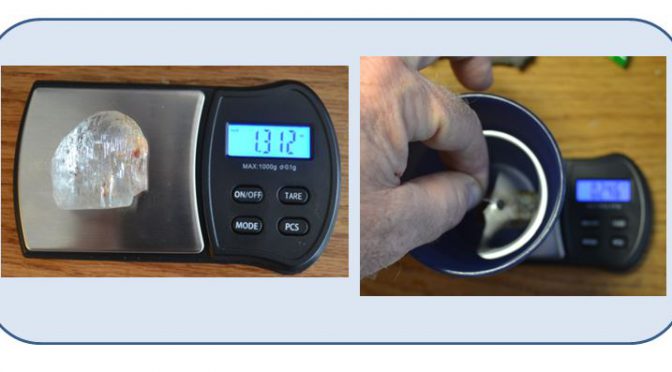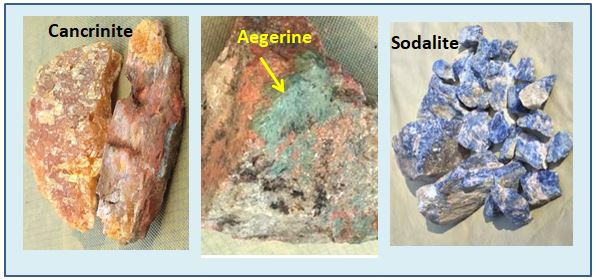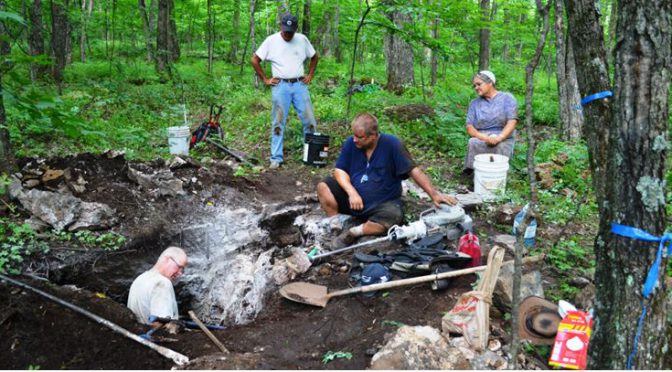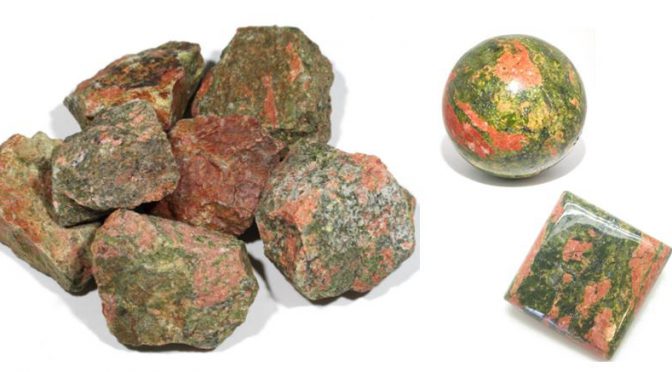For the past several years, I have had the pleasure of attending the Cornell Extension of Seneca County Outdoor Field day in mid-May. I enjoy explaining the science of geology, the role of geologists, and a bit about the three major rock groups and the rock cycle to 6th graders from schools throughout the county.
Category Archives: Geology
An Elemental Celebration
Published in May 2018 Wayne County Gem and Mineral Newsletter
Contrary to what you may have thought in high school, the Periodic Table of the Elements was not created to torture high school chemistry students. The idea was simple at first. Aristotle considered a four element table way back in 330 BCE. He identified earth, air, fire and water as the four elemental building blocks. But others since have not been satisfied with his simple approach, and the list grew and with that came complexity.
By the 1700s some 30 elements had been isolated and described and that grew to over 60 by the middle of the 19th century. And it was in the middle of the 19th century that several chemists and inventors working independently began to recognize patterns in those elements and began to organize them into lists and tables. A Russian chemist named Dmitri Mendeleev had the foresight to recognize that the known elements should be organized on their atomic weight and he also set the elements into a two-dimensional grid based on common properties. But it was his observations that the chart needed gaps for elements that had yet to be discovered that set him apart from others. For this insight, Mendeleev is credited as the “father of the Periodic Table”.
Glacial Erratics
Almost anywhere we wander in New York, we are apt to encounter glacial erratics, rocks that were transported to their current locations by the great sheets of ice that covered the state as recently as 10,000 years ago. Typically we just step over, or walk around, these aberrant rocks. That is, unless we trip on them, in which case we curse their existence before we move on. Farmers detest them too, but will use them to build stone walls or cobblestone barns. Once in a while we might notice something interesting in them and stop to smack them with our hammers or mauls. Typically they resist such actions, providing us a reason to detest them even more.
But there are some really famous glacial erratic boulders in the world. Some are famous for their size, others for their location. Perhaps you have a favorite one? I’ve selected a few to highlight.
Kaleidoscope Jasper, or is it?
Rob Webster arrived at the WCGMC February workshop with 11 pounds of colorful rock he had recently acquired and slabbed. He had purchased it online, where it had been identified as “kaleidoscope jasper” (or agate) from Utah. It did not, however, appear to be jasper and Rob said it had cut really easily. So, I took a picture and went home to investigate.
Fluorescent sodalite in Great Lake States
Perhaps you have heard of the latest collecting craze in the Upper Peninsula of Michigan? Beach collectors who have generally restricted their collecting to agates, amygdaloidal basalt, and perhaps an occasional greenstone are now returning to the beach after dark with a long wave UV light source. They are finding beach rocks that are bright yellow when subjected to a 365 nanometer long wave light source. Apparently there are some beaches where these stones are relatively common.
Morrisonite
All who attended the January workshop of the Wayne County Gem and Mineral Club acquired a nice unpolished slab of morrisonite jasper from the club collection. Most present at the event struggled to identify the “best” piece remaining when their raffle number was drawn. It was all so colorful and each piece was unique. I went home with my piece and decided to learn a bit more about my newest acquisition.
A Book Review: Balmat Mining District
Do you need an idea for a gift for that favorite mineral collector on your shopping list? Or perhaps you are like me, and you are looking to buy yourself a nice present? In either case, I may have the perfect book idea for you. How about “A Collector’s Guide to the Balmat District”?
Porphyroblasts
Porphyroblast: I’ve always thought that was such a neat word, maybe even interesting enough for a story. Say it out loud three times (“pore-fur-o-blast, pore-fur-o-blast, pore-fur-o-blast”). Now don’t you want to learn more, perhaps even own a few?
Porphyroblasts are those large recrystallized minerals that grow in the groundmass of a metamorphic rock, most typically in schists and gneisses. In New York State, we immediately think of the bright red almandine-pyrope garnets in the gneissic rocks in the Gore Mountain area, but the truth is the metamorphic schists and gneisses throughout New York and New England often contain garnet porphyroblasts. Unfortunately a lot of New York’s garnets are hosted in high-grade metamorphic gneiss and they don’t display crystal faces when the rocks are broken. Nevertheless they are large, colorful and fun to collect.
Collecting In-Between: Sand
Wayne County Gem and Mineral Club member Jim Rienhardt collects sand. In the November WCGMC Newsletter he tells us how and why. I thank him for letting me republish the article here.
by Jim Rienhardt:
Rock to sand to rock: Rock collectors collect on both ends. So do I, but I also collect from the middle – the sand. And, I am not alone. There are many, many people who collect sand and have tens of thousands of samples. But why, isn’t sand uninteresting? The same may be said by someone who doesn’t understand collecting rocks.
Clay Concretions in Sharon, Vermont
About 15,000 years ago the final of four glacial advances stopped in central Connecticut and a large end moraine was established. As the glacier retreated a large lake formed in what would become the Connecticut River Valley. Varved (seasonal) clay/silt layers were deposited. Debris (fossils, sticks, leaves, etc.) carried in with the clay/silt became nucleation points for calcite cementation and concretions grew in the clays. These unique concretions are now being exposed by erosion. The locals call them “Fairy Stones” or “Mud Babies”.
Lancaster, PA for pseudomorphs
On arrival the location does not look like a typical mineral collecting site. There are not any rocks to be seen. The GPS coordinates provided by Beard (2013) are smack in the middle of a cultivated field filled with small evergreen trees just off Fruitville Pike in Lancaster, PA. The field is flanked on two sides by subdivision housing and on a third side by a pair of little league baseball fields. Your first thought is that you botched the directions. Continue reading Lancaster, PA for pseudomorphs
The Hypathia Stone
We all dream of finding that special rock, one that is totally unique, one that can hold that center position on the top shelf of our mineral cabinet. Yes, that perfect piece we can be proud to display while telling the story of how we found it. In 1996, a geologist working for the Egyptian Geological Survey had his dream fulfilled. Aly Barakat was studying Libyan desert glass formed 26 million years ago, presumably by a meteorite impact, when he made his incredible find. As a geologist he knew that the colorful broken pebbles he found deep in the Saharan desert were unique, but it took more than two decades to learn how special they truly are. Continue reading The Hypathia Stone
zOrb65x Digital Microscope
I purchased a new toy in March. I acquired a Carson zOrb 65x Digital Microscope. Although not a tool for advanced photographers, I hoped that it would give me a simple tool for illustrating details I could not depict well with my Nikon. And for $50 I decided it was worthy of an experiment.
A Gastropod and Macrostrat
On occasion, cleaning out that old box of leftover and generally forgotten minerals from a past trip can provide an unexpected reward. Last month I uncovered a box of rather ordinary wavellite specimens from the club visit to Mount Pleasant Mills, PA in April of 2016. Among the cruddy and generally less than desirable wavellite discards I found a fossil gastropod that I had remembered collecting, but had pretty much forgotten. It was time to clean it up and do a little research. After all, that is what the winter months are for in western New York.
Micro-micro minerals
Some rockhounds like to collect rocks and minerals the size of small cars, or at least motorcycles. You know who you are (and so do the rest of us!). Others settle for samples that can be carried, a size that seems to decrease with each collecting season. But we also know of those who collect thumbnail specimens (less than 1”) and stick them into tiny boxes. There are even folks who like to collect specimens that require microscopes to be seen; these collectors are called micromounters. But I am going to tell you a bit about some “mineral specimens” that are even smaller. And I am even going to make up a new name for them. I am calling them micro-micro minerals.
The Origin of the Elements
Have you ever sat down to think about where the chemical elements in all those neat minerals we collect came from? I mean in the grand scheme of things, like as the universe forms and evolves.
We collect metallic minerals, like copper (Cu) in chalcopyrite and bornite and in colorful carbonate secondary minerals like malachite and azurite. The latter require carbon (C) as does calcite with its calcium (Ca) cation and dolomite when there is sufficient magnesium (Mg). WCGMC has travelled to Cobalt, Ontario in search of silver (Ag) in its pure form as well as cobalt in arsenic minerals (Co, As).
Measuring Specific Gravity
This note was published in the the Sept. 2017 WCGMC Newsletter
How do you try to identify an unknown mineral? If you are like most folks you start with color, which can help, but can also mislead. Trace elements and other types of inclusions can alter the color or many minerals. Does it have crystal faces? Maybe, but often not. Can you see a cleavage direction? Can you even distinguish crystal faces from cleavage? Calcite has rhombohedral cleavage, galena is cubic, but then fluorite is a cubic crystal with octahedral cleavage. That isn’t even fair. Luster helps with metallic minerals. Hardness can be helpful, but no one wants to scratch a prize find.
What about density, or more accurately specific gravity (sg). If it is magnetite or galena you can tell it is dense when you pick it up, but what about other minerals with specific gravity closer to the common minerals? Or heavy minerals that are not magnetic? Is there a method to easily measure specific gravity?
Rutter Pluton, French River, Ontario
For the second consecutive year, members of Wayne County Gem and Mineral Club joined with the Niagara Peninsula Geological Society for a several day trip to mineral sites in Ontario. We thank Ashley Pollock for organizing the trip and I thank Ashley for writing this short summary of one of the sites we visited and allowing me to publish it in the September, 2017 WCGMC newsletter and also this this blog.
It rained and then it stopped and then it rained again as we drove north to start our week long summer collecting trip. But when we met our Wayne County Club friends at our first collecting stop along the French River south of Sudbury, the clouds had parted and the week of fun began.
The Rutter Pluton is a nepheline-syenite intrusion within/ straddling the border of the Grenville Front Tectonic Zone (GFTZ) of the Grenville Province. The 10 km long, 2 km wide igneous body is dated at 975 million years. Like much of the Precambrian terrain in Ontario, the igneous rocks have been metamorphosed to a gneissic texture. Mineralogically, the pluton consists of nepheline, albite (plagioclase feldspar), potassium-feldspar, and biotite mica. Quartz is absent.
Calcite-Vein Dikes in Tory Hill, Ontario
The annual test of aging bones and muscles that we call the Wayne County Gem and Mineral Club quest for really old Ontario rocks was in July this year. The event lasted five days for several and eight days for four of us who continued on to Cobalt, Ontario. I am happy to report that all of us survived, and we have the pictures, stones, bruises, and mosquito bites to prove we were there. The whirlwind trip included collecting beryl and rose quartz in two pegmatites, a day in Eganville for apatite and biotite, a quarry stop for fossils, Princess Mine for sodalite, Schickler Mine for fluorite, Desmont Mine for mosquitoes, and Essonville Line roadcut for fluoro-richterite. Four of us carried on to Cobalt, grabbing some garnets along the way and finding one very nice silver-laced boulder at a mine dump in Cobalt.
The highlight of the trip had to be the day we spent with Canadian collector George Thompson on his mineral claims off Gibson Road in Tory Hill. We all thank him for sharing his calcite vein-dikes with us and allowing us to carry home memories of a fine day in the field. Oh, we took home some minerals also. And thus this note focuses on George’s property and the fifth day of our adventure. Continue reading Calcite-Vein Dikes in Tory Hill, Ontario
Unakite
In late June, Wayne County Gem and Mineral Club visited St. Lawrence County. One stop on the three day field trip was at the Valentine Mine in Harrisville where the quarry/mine operators, Gouverneur Talc Co., graciously permitted us our annual visit. Naturally all were drawn to the bright blue calcite and the brilliantly white wollastonite (the site’s economic resource), but there is another interesting rock to be collected there. Bright orange and green unakite can also be found.
